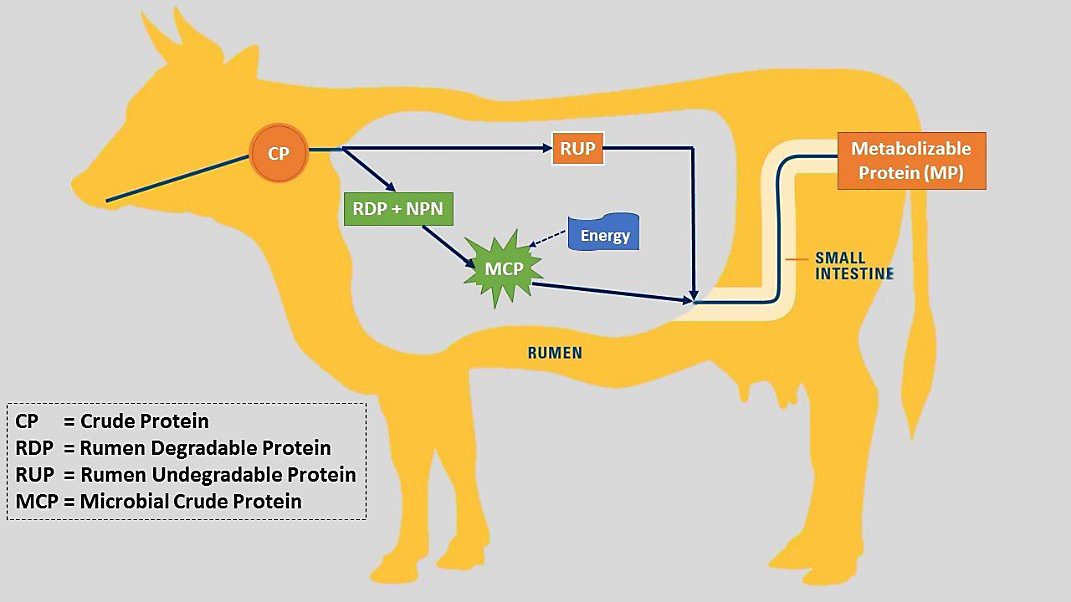You are viewing South Asia
- United States
- Canada
- Mexico
- South America
- EMENA
- Sub-Saharan Africa
- Russia
- South Asia
- Asia Pacific
- China
- Global
Choose Your Location:
- United States
- Canada
- Mexico
Popular Searches
- Animal Nutrition & Health
- Zenitro™
Zenitro™
Protein Balancing: Need of the Hour
Protein is a very critical nutrient for ruminant feed which plays a very important role in deciding the quantity as well as quality of the milk. Modern cattle feed manufacturers in India are also very much aware of this information. Nowadays many standards like BIS and others mention to have a minimum quantity of crude protein level in the feed. Crude protein can be maintained by the raw materials like oil seed cakes but the more the space is being taken by protein sources, less is the space available for energy sources. To balance the feed with respect to protein as well as energy and other nutrients is the key for the performance of the cattle feed.
Protein Nutrition for Efficient Dairy Farming in India
Protein is a critical nutrient in all dairy cattle diets. Signs of protein deficiency include lowered appetite, weight loss, poor growth, depressed reproductive performance and reduced milk quality and quantity. Young, growing and lactating animals are classes of ruminants most likely to require good quality and quantity of protein supplementation. Protein in dairy animal diet is commonly expressed as crude protein. To determine the crude protein content of a forage or feedstuff, the nitrogen content of the feed is measured first and the corresponding nitrogen value is multiplied by 6.25, because proteins typically contain 16 percent nitrogen (1 / 0.16 = 6.25). Crude protein is comprised of both true protein and non-protein nitrogen (NPN). Not all nitrogen-containing compounds are true proteins. Many NPN compounds can supply nitrogen to the rumen microbes that then build microbial protein in the rumen using this nitrogen along with the available carbon sources or energy. True protein is sometimes called “natural protein”. It is either degradable or undegradable in the rumen. Rumen Degradable Protein (RDP) is broken down in the rumen and Rumen Undegradable Protein (RUP) is the protein that cannot be broken down in the rumen but is potentially degradable in the small intestine. It is sometimes called Undegradable Intake Protein (UIP) or Rumen Bypass Protein. Crude protein is the sum of RDP and RUP. A minimum amount of RDP and NPN is needed in the diet to support microbial growth, which ultimately provides Microbial Crude Protein (MCP) to the animal which is a balanced protein in terms of the amino acids content with respect to the animal requirements. MCP and RUP together are called Metabolizable Protein (MP). Metabolizable protein (MP) separates protein requirements into the needs of rumen microorganisms and the needs of the animal. Metabolizable protein (MP) is the real protein absorbed in the intestine of the animal.

Non Protein Nitrogen
• With the genetic improvements of milk production traits in cattle, the challenge before the dairy farmers and feed manufacturers is to formulate quality feed at low cost.
• Protein is the costliest part of the cattle feed. So use of low cost protein source i.e. NPN source can be a viable solution.
Microbial Protein Synthesis
Synergy between ammonia release and energy source is critical for better microbial protein synthesis inside rumen.
Slow Release Non Protein Nitrogen
• Ammonia release from Non Protein Nitrogen (NPN) should be in correlation with the sugar release from the feed ingredients so that the nitrogen can maximally be utilized for microbial protein synthesis in the rumen.
• Energy source for ruminants are divided into three categories :-
1. Soluble sugar like molasses
2. Starches/ dextrin from grains
3. Cell wall carbohydrates from dry fodder
Thus the slow release NPN source should optimally release ammonia over the period of 6-8 hours so that it can be utilized by ruminal microbes for protein synthesis along with the rate of fermentation of various energy sources available in the animal diet.
Traditionally used NPN i.e. urea does not fulfill this requirement:-
- California Supply Chain Act
- Email Disclaimer
- GDPR Personal Data Addendum
- General Terms & Conditions for Vendors
- Global Environmental Policy Statement
- Indirect Cost Estimates
- Kemin Terms & Conditions
- Modern Slavery Act Transparency Statement
- Privacy Policy
- Sitemap
- Change Cookie Consent
- Animal Welfare Statement
© Kemin Industries, Inc. and its group of companies all rights reserved. ® ™ Trademarks of Kemin Industries, Inc., USA
Certain statements may not be applicable in all geographical regions. Product labeling and associated claims may differ based upon government requirements
